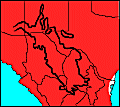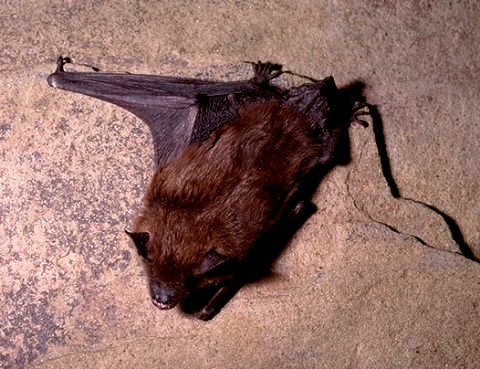


Eptesicus fuscus. Photographers: Dr. Robert Thomas and Margaret Orr. Copyright © 1999 California Academy of Sciences.
This is a medium-sized bat with a deep chestnut brown dorsal side. The ventral side is paler in color, the membranes are black, and the wings are short and broad (Davis and Schmidly 1994). It is plain-nosed with a long tail inside its naked interfemoral membrane. The ears are short and the tragus (an upward projection from the bottom of the ear opening) is blunt (Cockrum 1982). This bat averages 106-127 mm in length and weighs approximately 13-18 g (Whitaker 1980).
Eptesicus fuscus is usually a forest dweller, but it spends the summer months finding shelter in hollow trees or deserted areas of buildings. The winter months are spent within caves, mine shafts, buildings, storm sewers, or other protected areas at higher elevations (Whitaker 1980).
The food of this hunter consists of night-flying insects (Cockrum, 1982). Fecal material of these bats has shown their diet to include beetles, bees, flies, stone flies, May flies, true bugs, cockroaches, and so forth (moths, however, are seldom found) (Davis and Schmidly 1994).
They mate in the fall, and the one or two young that are produced are born between May and August. The offspring weigh approximately 3.0 g and grow at a relatively fast rate (up to 0.5 g gained each day). Maternity colonies of 20-300 individuals are located within buildings or other sufficiently large areas. The young begin foraging at 4 weeks of age, and they reach adult size about 8 weeks after birth (Davis and Schmidly 1994).
This bat is often confused with the Little Brown Bat and its related species. This one, however, is distinguished by its blunt tragus and larger size (Cockrum 1982). It does not feed in the winter and relies on the energy of its fat reserves instead (this constitutes one third of its body weight). The Big Brown Bat, reportedly, has the fastest flying speed at 40 mph of any other bat (Whitaker 1980). This particular species is relatively ferocious when captured, and it can produce a rapid ratchet-like sound while trying to bite its captor. Their known enemies include barn owls, horned owls, and black snakes (Davis and Schmidly 1994).
Cockrum, E. L. 1982. Mammals of the Southwest. University of Arizona Press, Tucson, 176 pp.
Davis, W. B., and Schmidly, D. J. 1994. The Mammals of Texas. Texas Parks and Wildlife Press, Austin, 338 pp.
Whitaker, J. O., Jr. 1980. The Audubon Society Field Guide to North American Mammals. Alfred A. Knopf, Inc., 745 pp.
§ The Mammals of Texas, Online Edition
Todd Spurgeon, Student, October 1997.
Last Update: 22 Jul 2009